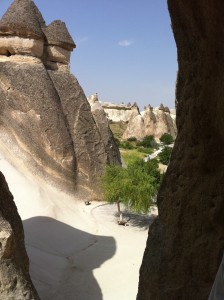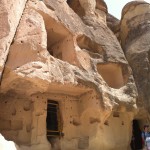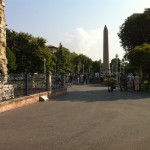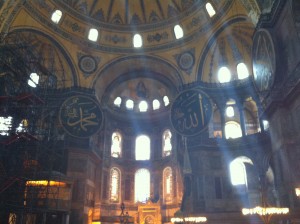Today, we only toured in the morning, but it was an inspiring and interesting day. We began with a short stop at the back side of the far end of the Hippodrome, which is the only part of the structure remaining. We hadn’t seen this Sunday, because it’s hidden from view by the buildings that were erected on its ruins. This last remaining part of the Hippodrome hints at its once awe-inspiring size and magnificence at a time when the Christian city was the envy of the world.
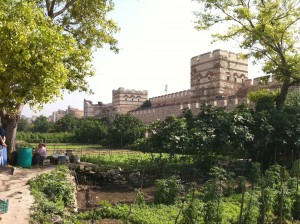
We next stopped at what was formerly the church of Saints Sergius and Bacchus but is now a mosque. It was not on the standard tour itinerary, but I’d come across it in the Byzantine history I’ve been reading and wanted to see it. So our tour guide arranged for us to see it. It was built by Emperor Justinian between 530-533 A.D. and is in remarkably good shape. Its marble columns look like they were hewn yesterday. The dome ceiling, marble columns and vaulted interiors create an impression of vertical space that is disguised by the exterior of the church. The vertical pull of the sanctuary was intended to direct one’s attention God. It succeeded.
You may wonder, “What’s the big deal with looking at old churches?” There are two things really. It’s the history for one; there is something about seeing a building erected 1,500 years ago that helps one transcend one’s own time and see the present through the more objective lens of the whole. But then there is the beauty. Devotion to God inspires the most creative impulses in the heart of man, and when one looks at churches like Hagia Sophia and SS Sergius and Bacchus, one is seeing clearly into the heart of men from a distance of 1,500 years.
The highlight of the day, and perhaps the trip thus far, was found at our next stop: the Theodosian Wall. This is the wall constructed by Theodosius II between 408 and 413 A.D. What’s the big deal about a wall? This wall, combined with the preexisting wall protecting the sides of the city facing the water, completely encircled the city–12 miles of walls. From the photograph you can see it disappearing in the distance. Just imagine it continuing for 12 miles. This wall successfully protected Constantinople for more than 1,000 years. During that time, only the crusaders in the Fourth Crusade breached the walls. Perhaps more on that tomorrow.
Walls were necessary at this point in history, as they are, though in a different form, today. But the future toward which the kingdom of God is progressing is a world where walls are unnecessary, where men will hammer their swords into plowshares and their spears into pruning hooks. (Isaiah 2:4). GS

